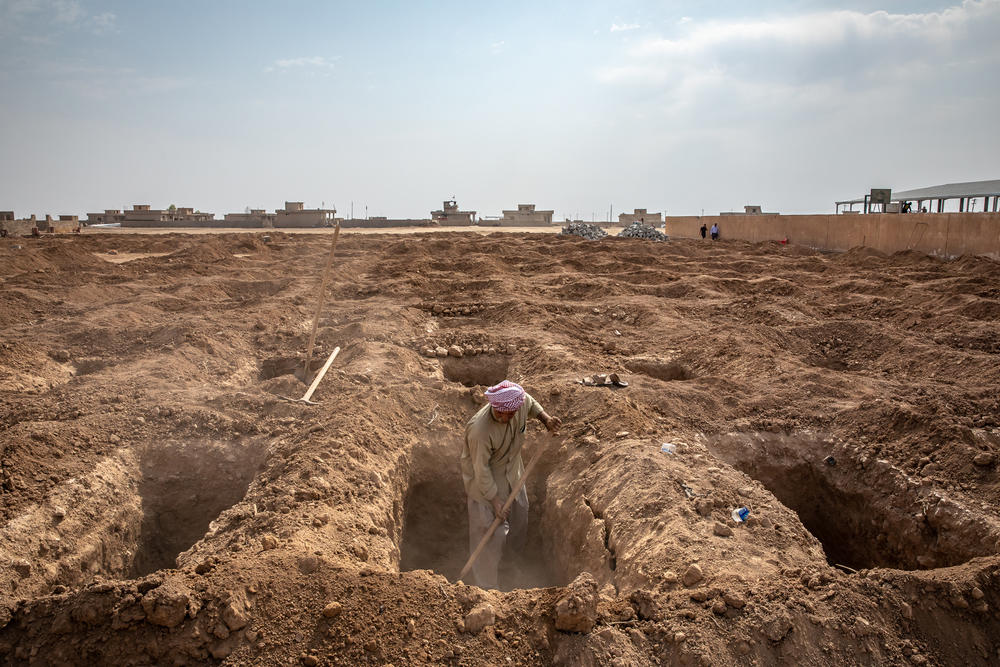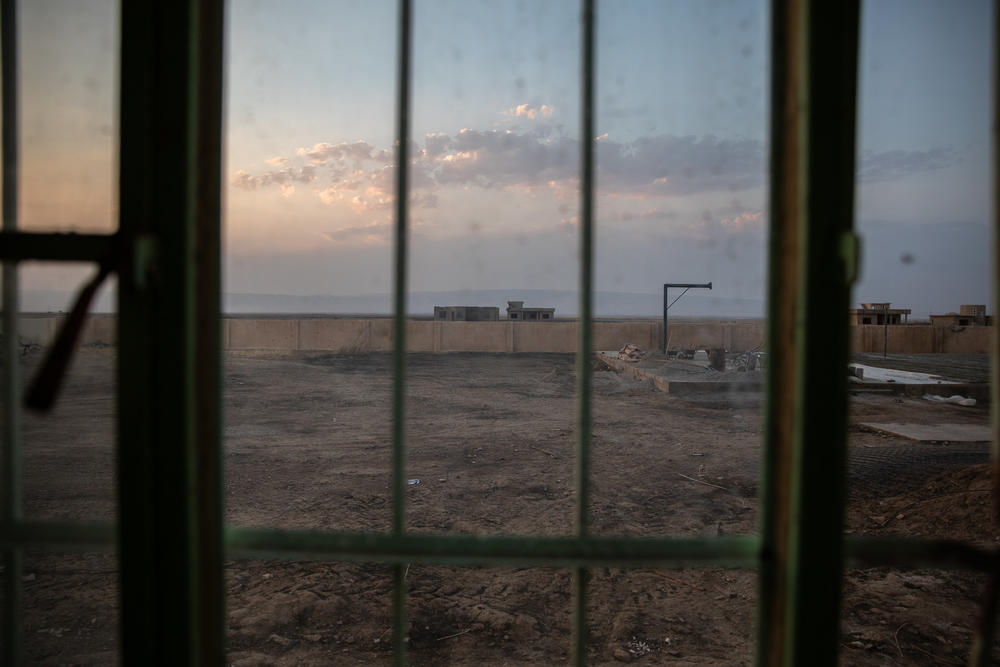Section Branding
Header Content
'Nothing Left In The World Except These Bones': Yazidis Search For Mothers' Remains
Primary Content
In the village of Solagh in the Sinjar region of northern Iraq, surrounded by fields where no crops grow, laborers in masks and white protective suits carefully sift through the sand and dirt of a former fish farm.
They take turns shoveling the sand into a rectangular, coffee table-size wire sifter to make sure they don't lose small pieces of bone.
They are looking for the remains of women whom ISIS deemed too old for sexual slavery when it embarked on genocide against the Yazidi religious minority six years ago. ISIS killed the women — at least 80 of them — and tossed their bodies into a pit. The former fish farm is now known as "the mothers' grave."
A photographer takes photos to be used as possible evidence of war crimes.
So far, Iraqi and international investigators have discovered 17 mass graves in Sinjar, containing the bodies of some of the 3,000 Yazidis killed by ISIS.
Even for survivors of almost unimaginable violence and loss, the grave in Solagh prompts a special anguish.
"This grave is the hardest for us to stand," says Layla, 40, whose husband and three sons were killed by ISIS. "We are seeing them open the graves of our own mothers."
Layla, who asks that her full name not be used because she is still afraid of the ISIS fighters who enslaved her, lost her mother and two aunts, among 20 relatives killed by ISIS.
"We have nothing left in the world except these bones," she says in a nearby center, where she and other Yazidis are giving blood samples for DNA tests to try to identify their relatives' remains. "We want to visit them during the feasts in proper graves. We want to sit down beside their graves and pray for them."
The towns and villages on and around Sinjar Mountains, interspersed with fields of tobacco and grazing sheep, are the Yazidi homeland. Yazibi is an ancient religion – monotheistic and misunderstood by most outsiders. In the genocide that began in August 2014, ISIS declared Yazidis infidels. Convoys of fighters invaded the Sinjar region, intent on eradicating the religion. Kurdish security forces in charge of the region retreated, leaving the Yazidis defenseless.
The U.S. entered the war against ISIS with airstrikes to try to protect Yazidis who had fled to the Sinjar mountain area, but the intervention came days after ISIS began slaughtering villagers.
Most of the women whose remains are believed to be in the grave in Solagh came from the nearby village of Kocho. There, on Aug. 3, 2014, ISIS killed almost all the men and older boys before loading the women and children onto trucks.
In Solagh, they shot older and heavily pregnant women whom they did not want to take care of. They buried other women alive, according to witnesses — pushing them into the pit and using a bulldozer to cover them with sand.
One of the victims that day was the mother of Nobel Peace laureate Nadia Murad, who was 19 when ISIS kidnapped her.
"My mother was the most peaceful, charitable person," says Nadia's brother Saeed Murad, 28, standing outside the yellow tape as investigators use trowels to excavate remains. "If she saw a poor person and we had only one piece of bread, she would cut it into half and give it to him."
He is one of the few survivors from Kocho. Shot six times by a young ISIS fighter, he survived because he was left for dead among the bodies.
With all the tragedy and loss, he says his heart "has turned to stone," but as he talks about his mother, Samme Salih Amman, he removes his dark sunglasses to wipe tears from his eyes.
"Nadia and I didn't get to spend enough time with her. We needed to have her with us longer," he says.
Partly because of the presence of explosives and land mines in the area, it took four years after the region was liberated from ISIS in 2015 to begin excavating the first of Sinjar's shallow graves. Some of the remains have since been scattered and lost.
"When I came back and saw this, I was very depressed because I could see their clothes and bones," Murad says. "They all disappeared – I don't know who took them – maybe animals got them or some group took them away."
He visited Europe and, like his sister, who moved to Germany, could have stayed there as a refugee. But this land, which contains the still-undiscovered remains of so many Yazidis, has a hold on him.
"I was hoping to forget what happened ... but it didn't work. I came back to Iraq," says Murad, now a fighter with Yazidi paramilitary forces. "I want to live and die here."
He believes this and other graves also contain the bodies of his aunts, uncle and cousins' wives. At least two of his brothers, killed by ISIS, were among the bodies identified after being excavated from a grave in Kocho last year.
In conjunction with the International Commission on Missing Persons and UNITAD, the United Nations investigative body for ISIS war crimes, the Iraqi government has identified about 150 Yazidi victims through DNA tests. But the coronavirus pandemic has delayed the return of their remains from Baghdad to families for reburial.
Last year, in the expectation that they would soon receive their relatives' remains, many families bought new clothes that loved ones are traditionally buried in, taking them to be blessed in the sacred Yazidi temple of Lalish.
"There are no bodies left, so we can't dress them — but we will put the clothes on top of their bones," says Khaled Murad, another of Nadia's brothers.
There has been so much trauma in the village of Kocho, the living have all deserted it.
The homes where families were rounded up by ISIS fighters — men they had known and trusted from neighboring Arab villages — are damaged and abandoned. Winding dirt roads lead to straw and mud houses with collapsing plaster. Trees stand burned and blackened.
On that August day in 2014, the villagers were ordered at gunpoint to gather at the village school. In the schoolyard — where ISIS separated Yazidis into groups of those they would kill immediately and those they planned to enslave — there are 517 new burial plots. Yazidi relatives and volunteers dug them last year to rebury victims identified from mass graves.
Last year, on the fifth anniversary of the massacre, Saeed walked through the crumbling remains of his family's former home. A white cloak his mother used to wear hung in the corner near whitewashed walls now covered in cobwebs.
A pair of sewing scissors and a dust-covered green plastic comb lay on a home-made wooden cupboard with flaking red paint.
Outside in the yard, a cassette tape sat on cracked dresser with the doors falling off the hinges. The black button eyes of a discarded stuffed toy, now shapeless and almost colorless from exposure to the elements, peered out from the dried grass.
More than 3,000 Yazidis remain missing – some still held by ISIS fighters or their families and others believed to have been trafficked to Turkey, Europe and elsewhere. Many are presumed dead — killed in airstrikes targeting ISIS or lying in mass graves yet to be excavated.
Saeed Murad says after the ISIS fighter shot him in Kocho, he rolled down a hill and could see ISIS fighters loading women and girls onto trucks to be sold in slave markets in Syria and the Iraqi cities of Tal Afar, 45 miles down the road from Kocho, and Mosul.
He says he has seen a water well near the city of Hawija, into which Yazidis were thrown after being killed. He believes there are hundreds more bodies in another well in Tal Afar, a city he frequently drives past.
Many Yazidi families greet the news that a loved one has been identified with a mixture of dread and relief. The process of identifying all the remains will take years. Fawaz Abdulabbas Abdulameer, deputy head of the Iraq mission of the International Commission on Missing Persons, notes the Hague-based organization is still identifying bodies from mass graves in Bosnia — more than two decades after that conflict ended.
For Yazidis, identification depends on the DNA tests, which ideally need samples from three close living family members.
"But sometimes," he says, "we face cases where every member of the family is missing."
In Solagh, the exhumation of the mothers' grave began with a ceremony.
Yazidi musicians played wooden flutes and beat traditional skin drums as spiritual leaders led prayers. Relatives of the women in the grave sobbed, remembering that day in August and all the anguish that came after.
But for every relative who knows where their loved ones are buried, there are thousands more endlessly searching, wondering whether their loved ones might be in graves still to be discovered.
Sangar Khaleel contributed to this report from Sinjar.
Copyright 2020 NPR. To see more, visit https://www.npr.org.











